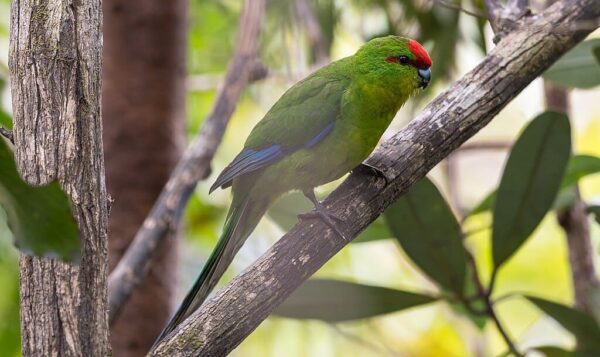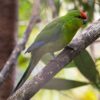
Cyanoramphus

saisseti
Size:
26 cm (10.2 in)
Weight:
100 g (3.5 oz)
Subspecies including nominate:
one
Colour Adult:
Bright green in general. Red frontal band, lores and line through eye. Narrow red line on ear-coverts. Center of crown red extending back to above eye. Yellow-green superciliary area. Red patch on either side of rump. Primary wing coverts, alulua and outerwebs of primaries violet-blue; fine yellow outer margin to outer primaries. Wing-bar in some males. Bright yellow throat, underparts yellow-green. Uppertail green lightly washed with blue; undertail dark grey. Beak blue-grey tipped with black. Eye dark red. Females usually have wingbar.
Colour Juvenile:
Juveniles show a wingbar, otherwise as in adult.
More Information:
WPT-supported project – New Caledonian Parakeet Conservation
Content Sources:
CITES
Avibase
Parrots of the World, Forshaw, 2010.
Cornell Lab of Ornithology/Birds of the World
A Guide to Parrots of the World, Juniper and Parr, 1998.
Research: Spatial ecology and conservation of parrots of New Caledonia
Parrots in Aviculture, Low, 1992.
Lexicon of Parrots, Thomas Arndt.
Captive Status:
—
Longevity:
Probably similar to C. novaezelandiae: 10 years
Housing:
Most likely similar to C. novaezelandiae: Aviary at least 3.5 x 1 x 2 m (10 x 3 x ft). Free-flying possible. Provide protection from cold.
Diet:
Probably as in C. novaezelandiae: Small seed mix such as: canary, millet and smaller amounts of oats, buckwheat, safflower and a little hemp; limited sunflower seed; spray millet; green leaves such as: Swiss chard, lettuce, sowthistle, dandelion, chickweed; seeding grasses; rearing food made from hard-boiled egg, wholegrain bread and carrot, all ground to crumbly consistency; complete pellet.
Enrichment:
Probably similar to C. novaezelandiae: Loves to climb, therefore provide ladders, ropes and swings; not a vigorous chewer. Provide large flight for exercise. Provide areas for bathing.
Nest Box Size:
Vertical box 8″ x 8″ x 14″ (20.3 cm x 20.3 cm x 35.5 cm).
Clutch Size:
2-4
Fledging Age:
Probably as in C. novaezelandiae: 5-6 weeks
Hatch Weight:
—
Peak Weight:
—
Weaning Weight:
—
World Population:
Unknown, decreasing.
IUCN Red List Status:
Least Concern
CITES Listing:
Appendix I
As conspecific of C. novaezelandiae.
Threat Summary:
It is suspected to be declining due to the effects of predation by invasive species. In the near future, it may decline more rapidly if habitat is lost to nickel mining.
Range:
Found on New Caledonia.
Habitat:
Found in indigenous montane forests.
Wild Diet:
Feeds on fruits and seeds of casuarinas and pawpaws Carica papaya, and other plants.
Ecology and Behaviour:
This species has a scattered range, mostly rain forest and forest edges. There are also reports that it tolerates Niaouli savanna, Maquis scrub and humid forest to 1,500 m. It is most abundant in Gymnostoma preforests and in wet forests from 400-800 m. Quiet and difficult to observe in canopy. Will forage for seeds on the ground.
Clutch and Egg Size:
2-4
Breeding Season:
November-January. Nest is in tree hollow.

